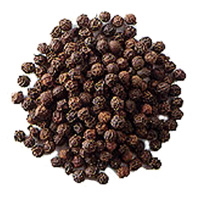Hindi Name : Gol Mirch
General Description :

The best Pepper of commerce comes from Malabar. Pepper is mentioned by Roman writers in the fifth century. The plant can attain a height of 20 or more feet, but for commercial purposes it is restricted to 12 feet. The plant is propagated by cuttings and grown at the base of trees with a rough, prickly bark to support them. Between three or four years after planting they commence fruiting and their productiveness ends about the fifteenth year. The berries are collected as soon as they turn red and before they are quite ripe; they are then dried in the sun.
Geographical Sources : Black pepper is native to Malabar, a region in the Western Coast of South India; part o the union state Kerala. It is also grown in Malaysia and Indonesia since about that time when it was found in the Malabar Coast. In the last decades of the 20th century, pepper production increased dramatically as new plantations were founded in Thailand, Vietnam, China and Sri Lanka. The most important producers are India and Indonesia, which together account for about 50% of the whole production volume.
History /Region of Origin : In South India wild, and in Cochin-China; also cultivated in East and West Indies, Malay Peninsula, Malay Archipelago, Siam, Malabar, etc.
Varieties :
In trade, the pepper grades are identified by their origin. In India - The most important Indian grades are Malabar and Tellicherry (Thalassery). The Malabar grade is regular black pepper with a slightly greenish hue, while Tellicherry is a special product. Both Indian black peppers, but especially the Telicherry grade, are very aromatic and pungent. In the past, Malabar pepper was also traded under names like Goa or Aleppi. Cochin is the pepper trade center in India.
In South East Asia, the most reputated proveniences for black pepper are Sarawak in Malaysia and Lampong from Sumatra/Indonesia. Both produce small-fruited black pepper that takes on a greyish colour during storage; both have a less-developed aroma, but Lampong pepper is pretty hot. Sarawak pepper is mild and often described fruity.
Composition :
Piperine, which is identical in composition to morphia, volatile oil, a resin called Chavicin. Its medicinal activities depends mainly on its pungent resin and volatile oil, which is colourless, turning yellow with age, with a strong odour, and not so acrid a taste as the peppercorn; it also contains starch, cellulose and colouring. Black pepper contains about 3% essential oil,
The essential oil of white pepper has received less attention; the content of essential oil is lower (1%).The pungent principle in pepper is an alkaloid-analog compound piperine.
Good quality cloves :
Pungent and aromatic. The pungency is strongest in white pepper and weakest in green pepper, while black and green pepper are more aromatic than the white one. Taste and Aroma Malabar for weight, Sumatra for colour, and Penang for strength. Pepper has an aromatic odour, pungent and bitterish taste.
Adulteration :
Linseed mustard seed, wheat and pea-flour, sago, ground rice. At one time when the duty levied on Pepper was very high, fictitious peppercorns were made of oil-cake, clay, with a little cayenne added.
Our Black Pepper :
| Variety |
Extraneous Matter not exceeding |
Light berries not exceeding(%) |
Moisture Content not exceeding |
General Characteristics |
| MG1 |
0.5 |
2.0 |
11 |
Dried mature berries, dark brown, garbled from South India |
| TGSEB |
0.5 |
3.0 |
11 |
Dried mature berries, dark brown to black, garbled from South India with wrinkled surface |
| A55 |
0.5 |
2.0 |
11 |
Dried mature berries, dark brown, garbled from Karnataka, India with high pungency |




 The best Pepper of commerce comes from Malabar. Pepper is mentioned by Roman writers in the fifth century. The plant can attain a height of 20 or more feet, but for commercial purposes it is restricted to 12 feet. The plant is propagated by cuttings and grown at the base of trees with a rough, prickly bark to support them. Between three or four years after planting they commence fruiting and their productiveness ends about the fifteenth year. The berries are collected as soon as they turn red and before they are quite ripe; they are then dried in the sun.
The best Pepper of commerce comes from Malabar. Pepper is mentioned by Roman writers in the fifth century. The plant can attain a height of 20 or more feet, but for commercial purposes it is restricted to 12 feet. The plant is propagated by cuttings and grown at the base of trees with a rough, prickly bark to support them. Between three or four years after planting they commence fruiting and their productiveness ends about the fifteenth year. The berries are collected as soon as they turn red and before they are quite ripe; they are then dried in the sun.